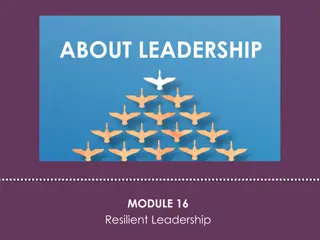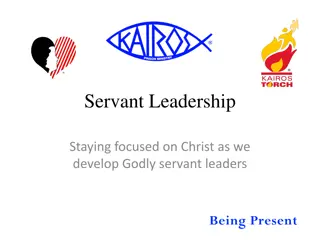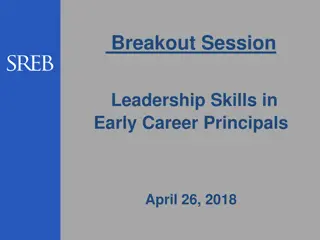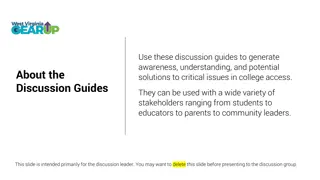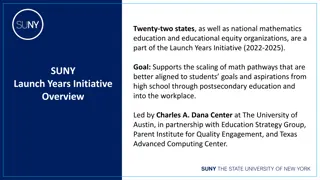
Shifting Roles: Leader of Others to Leader of Leaders in PSJA
Embrace the transition from being a Leader of Others to a Leader of Leaders in PSJA to enhance your impact on campus. This guide outlines key skills, prerequisites, and distinctions for success in leadership roles, providing valuable insights on navigating this shift effectively.
Uploaded on | 0 Views
Download Presentation

Please find below an Image/Link to download the presentation.
The content on the website is provided AS IS for your information and personal use only. It may not be sold, licensed, or shared on other websites without obtaining consent from the author. If you encounter any issues during the download, it is possible that the publisher has removed the file from their server.
You are allowed to download the files provided on this website for personal or commercial use, subject to the condition that they are used lawfully. All files are the property of their respective owners.
The content on the website is provided AS IS for your information and personal use only. It may not be sold, licensed, or shared on other websites without obtaining consent from the author.
E N D
Presentation Transcript
Guide 2 Expanding Your Impact in PSJA: Shifting from a Leader of Others to Leader of Leaders
Leader of Others to Leader of Leaders From Leader of Others to Leader of Leaders Leader of Campus As you grow in your PSJA staff leadership level, you expand your impact on the campus. Leader of Leaders Leader of Others At every level, Leaders receive development and support. All leaders must apply on the PSJA jobs website in order to be considered for a new role. Leader of Self Students
Leader of Others to Leader of Leaders This guide outlines key distinctions in shifting from a Leader of Others to a Leader of Leaders A Leader of Others leads a team and is responsible for delivering results through others; a Leader of Leaders delivers results through other leaders and creates conditions for leaders to succeed. While these roles will look different at the Elementary, Middle and High School levels, we have outlined the general key skills and abilities needed for success on any campus. Prerequisites for Leader of Leaders Roles: Example Leader of Leaders Roles: Leader of Others Leader of Leaders While prerequisites vary by role, requirements for a Leader of Others role generally include: Collaborative Learning Facilitator Content Department Heads Grade Level Chair Instructional Coach Assistant Principal Master s Degree Valid Texas Teaching and Administrative Certificate 3+ Years of successful teaching experience Please note: Reviewing these resources does not guarantee a new position: if you d like to be considered for a new role, please visit the PSJA Jobs page to apply.
Leader of Others to Leader of Leaders Key shifts in Positive Engagement See next page for aligned learning opportunities Spirit of PSJA Competencies Leading Others (level-specific behaviors) Leading Leaders (level-specific behaviors) Builds Relationships Cultivates team members feeling of belonging through words and actions, including reinforcing team, school, and district goals and articulating importance of individual work to these goals Reinforces common understanding of collective goals among staff through words and actions (including recognition) and coaches team leaders to foster sense of belonging among team members Key Distinctions A Leader of Others identifies team members opportunities for growth and provides support to develop their capabilities A Leaders of Leader mentors team leaders to become better mentors to their team members and to become future organizational leaders Communicates Effectively Models and coaches effective verbal and written communication for team members, facilitating the dissemination of information from campus and district leadership with fidelity, clarity, speed, and careful consideration of importance, relevance, and volume Effectively communicates information both orally and in writing to staff, students, and parents/caregivers in a manner that reflects the best interests of the district, school, and students, providing leaders with guidance and clarity on expectations for the dissemination of information Key Distinctions A Leader of Others focuses on disseminating information and communicating effectively with their team A Leader of Leaders communicates with a department-wide view and supports team leaders to communicate effectively with their own team Models Ethics Establishes trust with team members by modeling high standards of honesty, fairness, and confidentiality, setting clear and consistent expectations for team members, and recognizing and appreciating specific behaviors in line with district values Establishes trust with students, parents, and staff by modeling high standards of honesty, fairness, and confidentiality; Provides coaching and feedback on practices of team leaders and creates consistent practices of recognizing and appreciating specific behaviors in line with values at all levels Key Distinctions Leaders of Others support systems of accountability Leaders of Leaders focus on the implementation and implementation strategy for systems that ensure campus-wide safety Exhibits Professionalism Supports team function by encouraging self-awareness around emotions, behaviors, and mindset in team members and providing appropriate resources and support for cultivating emotional intelligence Models self-awareness and self-management around emotions, behaviors, and mindset; Provides resources and coaching for leaders to leverage to support team members for increased emotional intelligence Key Distinctions Leaders of Others coach their team members Leaders of Leaders coach team leaders
Leader of Others to Leader of Leaders Expanding your impact in Positive Engagement Overall Key Shift in Positive Engagement: An increased amount of time spent building relationships and using effective communication to deliver results through others Spirit of PSJA Competencies Job-embedded experiences & resources for growth Look for opportunities to: Builds Relationships -Schoology course on developing others -Article: How to set SMART Development Goals - a guide for staff and managers Coach others on conflict resolution Create systems to celebrate and value diversity Model respectful behavior to all Design a structure to distribute leadership to others on your team. Delegate and monitor the work. Communicates Effectively -Book: The Speed of Trust (summary) -Article: Building teacher collaboration school-wide -Article: Creating Collaborative Cultures -Article: 8 lessons from most improved schools on building collaborative cultures Model communications expectations Invite feedback and ideas from staff Adapt communication to address stakeholder needs Models Ethics -HBR: Level 5 Leadership: The Triumph of Humility and Fierce Resolve Allocate time to modeling and enforcing systems Exhibits Professionalism -Article: How to be a better listener Model positivity and optimism about work
Leader of Others to Leader of Leaders Key shifts in Student-Centered Excellence See next page for aligned learning opportunities Spirit of PSJA Competencies Leading Others (level-specific behaviors) Leading Leaders (level-specific behaviors) Demonstrates Expertise Demonstrates expertise and models continuous desire to learn; Engages team in building and implementing expertise and continuously exploring better ways to meet team goals Demonstrates expertise and models continuous desire to learn; Provides opportunities for team leaders to engage in continuous learning Challenges and supports team leaders to explore current research and best practices to advance student learning and school performance Key Distinctions A Leader of Others is responsible for continuously finding a way to improve team outcomes A Leader of Leaders focuses on advancing department-wide outcomes Establishes a Shared Vision Engages team in interpreting and incorporating campus mission and vision into their work Engages/coordinates team leaders in creation and support of campus mission and vision; Actively aligns own work and demonstrates commitment to common vision in word and action Key Distinctions A Leader of Others spends significant time cultivating a shared vision among one team A Leader of Leaders is responsible for more complex vision-setting work, such as using personal stories to share personal convictions regarding teaching and learning Implements Plan Supports team members to maximize use of time for activities related to campus mission, vision and goals, prioritizing time and space for highest leverage activities Coaches leaders on project management to accomplish goals; Models effective time management, organization, prioritization, and follow through to optimize focus on learning and minimize distractions Key Distinctions A Leader of Others is responsible for delegating work and creating project plans for a team to accomplish goals A Leader of Leaders spends time coaching leaders on project management and using data to monitor progress across several teams Expects Results Engages team members in implementing aligned practices to meet and exceed external standards of accountability Coordinates and supports leaders across teams with structures to meet and exceed external standards of accountability Key Distinctions A Leader of Others spends time monitoring team progress A Leader of Leaders values department-wide progress
Leader of Others to Leader of Leaders Expanding your impact in Student-Centered Excellence Overall Key Shift in Student-Centered Excellence: An increased amount of time spent implementing systems and structures in order to deliver results through others Spirit of PSJA Competencies Job-embedded experiences & resources for growth Look for opportunities to: Demonstrates Expertise Identify patterns across data Use insight to solve complex problems affecting multiple campus teams Create data-driven plans and monitor progress Demonstrate belief and willingness to learn Book: Leaders of Learning How District, School, and Classroom Leaders Improve Student Achievement Outline a series of professional learning through various sources podcasts, books, articles and share your plan and reflections with teams Establishes a Shared Vision School-wide goal setting template/example Create structures that enable teams to share results and progress toward goals Design an innovation challenge to elicit ideas from team members about new ways of working or to solve a pressing problem Implements Plan Set detailed expectations Track progress using appropriate benchmarks and performance measures Resource: RAPID framework for decision-making (identifying roles in a decision-making process) Convene a council of diverse staff to address 2-3 team or grade level issue Define roles and responsibilities for all and delegate the implementation of ideas. Be sure to record and solicit feedback on progress of working team model Expects Results Article: Using Student Achievement Data to Support Instructional Decision-making Article: 7 Steps to Becoming a Data-Driven School Conduct after action review of a new or stagnating initiative with your team. Gather stakeholder feedback along with quantitative data to ensure the assessment is robust Hold leaders accountable for results
Leader of Others to Leader of Leaders Key Shifts in Joint Empowerment See next page for aligned learning opportunities Spirit of PSJA Competencies Leading Others (level-specific behaviors) Leading Leaders (level-specific behaviors) Builds Capacity Leads team in developing individual and team goals for development in alignment with campus goals and facilitates conversations to allow team members to learn from one another Provides opportunities for coaching and development for campus leaders to support their roles in developing departments/teams Key Distinctions A Leader of Others uses leadership skills to maximize the work of individual contributors and team as a whole A Leader of Leader focuses on coaching campus leaders to support their skills to develop team capacity Promotes collaboration Fosters mutual respect and trust among team members to maximize collaborative work Provides resource/tools to leaders to support collaboration of teams; Provides support and structures for distributed leadership and assigned tasks Key Distinctions A Leader of Others cultivates a collaborative team environment A a Leader of Leaders facilitates effective collaboration across teams Inspires action Cultivates team commitment to achieve campus/district mission and vision for all students Works with leaders to actively monitor campus initiatives to fairly and equitably addresses the needs of all students Key Distinctions A Leader of Others uses both direct and indirect influence on others to achieve goals A Leader of Leaders serves as both a role model and an expert within the department they manage Develops leaders Identifies and promotes strengths in team members to support their development within the campus and district Effectively assigns tasks to leaders in ways that provide learning experiences and ensures the efficient operation of the campus Key Distinctions A Leader of Others spends time coaching and providing specific, constructive feedback to grow team and team members; and focuses on delegating tasks to individual contributors A Leader of Leaders is responsible for creating department-wide goals that align to the campus and district vision; also spends time strategically assigning tasks to leaders in ways that ensure effective campus-wide operations
Leader of Others to Leader of Leaders Expanding your impact in Joint Empowerment Overall Key Shift in Joint Empowerment: An increased amount of time spent developing leaders in order to deliver results through others Spirit of PSJA Competencies Job-embedded experiences & resources for growth Look for opportunities to: Builds Capacity Radical Candor framework Six Steps for Effective Instructional Feedback 2x2 Feedback form Design and implement an ongoing process through which feedback from multiple stakeholders is gathered and implemented on a school-wide challenge/problem of practice Design staff professional learning Practice providing growth-oriented feedback to team members Promotes collaboration Book: Crucial Conversations: Tools for Talking when the Stakes are High (excerpt) Article: Turning Conflict into Partnerships Article: The Five Steps to Conflict Resolution HBR Article: How to Create Team Norms - and make them stick Value input and collaboration with diverse set of stakeholders Inspires action Create systems for new ideas to be shared and sustained Blog: Encouraging a culture of positive risk taking Develops leaders HBR Article: What Science Says about Identifying High Potential Employees Article: How to spot high-potential employees in your organization Article: Ten Roles for Teacher Leaders Blog: Helping teachers become leaders Resource: Retaining high-performing teachers Design a professional development cadence for the staff, execute it, and evaluate its effectiveness. PD should form a coherent sequence around a critical issue that the campus has identified Manage performance across teams by focusing on needed areas of improvement and enhancing strengths
Leader of Others to Leader of Leaders Key Shifts in Adaptive Innovation See next page for aligned learning opportunities Spirit of PSJA Competencies Leading Others (level-specific behaviors) Leading Leaders (level-specific behaviors) Scans environment Helps team understand campus role and accountability to larger educational system Facilitates connections between team leaders to support function of campus systems Key Distinctions A Leader of Others holds their team accountable for collective impact in line with campus and district goals A Leader of Leaders ensures that all work streams within their department are aligned and that deliverables are produced on time within communicated deadlines Champions solutions Receptive to new ideas/perspectives from team members Integrates ideas/perspectives from leaders to support campus innovations Key Distinctions A Leader of Others supports direct reports in solving problems through team facilitation and coaching A Leader of Others supports team leaders in solving conflict and implementing department wide solutions Manages change Supports team persistence and resilience in face of challenges Coaches and supports leaders to respond with resilience in unexpected or challenging situations Key Distinctions In times of challenge, A Leader of Others must focus on both on their own and their team s resilience A Leader of Leaders must create a departmental culture focused on continuous improvement and ensure that their team leaders can address challenges and create solutions for impact Acknowledges outcomes Consistently leads team to evaluate areas of need and examine results in order to improve Supports leaders in monitoring results and acknowledging successes and areas of concern Key Distinctions A Leader of Others coaches others to recognize their areas of need and examine results in order to improve A Leader of Others drives for department-wide excellence
Leader of Others to Leader of Leaders Expanding your impact in Adaptive Innovation Overall Key Shift in Positive Engagement: An increased amount of time spent managing change in order to deliver results through others Spirit of PSJA Competencies Leading Others (level-specific behaviors) Leading Leaders (level-specific behaviors) Scans environment Article: Creating Collaborative Cultures Article: 8 lessons from most improved schools on building collaborative cultures Take calculated risks and have awareness of environment & impact Champions solutions Book: Switch: How to change things when change is hard HBR Article: Don t just tell employees change is coming - explain why Design systems to invest all team members & hold them accountable for campus-wide goals Provide opportunities for teams to solves problems in new ways Manages change Identify a critical need or campus area of focus and develop a plan for creating positivity and optimism among staff around that issue Engage all in change Acknowledges outcomes Toolkit/strategies for instilling a growth mindset in schools from Transforming Education Reflective cycle model Recognize and celebrate staff in meaningful ways







